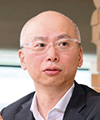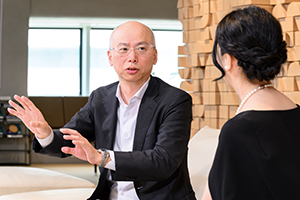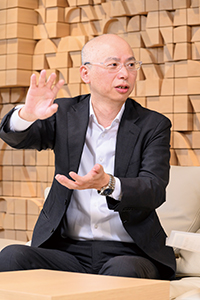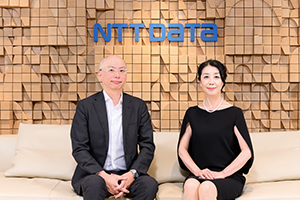 |
|
|
|
|
|
View from the Top Vol. 22, No. 10, pp. 1–6, Oct. 2024. https://doi.org/10.53829/ntr202410tp1
The Client’s Perspective Is Essential for Creating Usable Technology. Evolving to an Asset-based Business Model and Strengthening the Capability to Use Advanced Technologies and System Development TechnologiesAbstractIn July 2023, NTT DATA shifted to a three-company structure consisting of NTT DATA Japan Corporation, which operates a business in Japan, NTT DATA, Inc., which operates a business outside Japan, and NTT DATA Group Corporation, the holding company that oversees the two aforementioned companies. Under the slogan “Realizing a Sustainable Future,” NTT DATA is promoting a sustainable management. We interviewed Hidehiko Tanaka, senior vice president, head of Technology and Innovation General Headquarters, NTT DATA Group Corporation, about the technology strategy and vision of NTT DATA under the new structure. Keywords: technology strategy, technology assets, technology focus areas The Technology and Innovation General Headquarters oversees the technology development and formulates a technology strategy for NTT DATA as a whole—NTT DATA transformed into a new organizational structure. What role does the Technology and Innovation General Headquarters play under the new structure? In 2023, 35 years after its founding in 1988, NTT DATA made a new start by shifting to a three-company structure consisting of NTT DATA Japan Corporation, the operating company responsible for business in Japan, NTT DATA, Inc., the operating company responsible for business outside Japan, and NTT DATA Group Corporation, the holding company that oversees the two aforementioned companies. The aim of this organizational change is to expand business scale and promote agile management appropriate for the fast-changing digital era. As an organization within NTT DATA Group Corporation (the holding company), the Technology and Innovation General Headquarters is now in a position to oversee the technology development and formulate a unified technology strategy for NTT DATA as a whole and promote the development and utilization of technology assets both in Japan and abroad. In accordance with our Mission Statement of “NTT DATA uses information technology to create new paradigms and value that help contribute to a more affluent and harmonious society,” we are supporting society through the provision of information technology (IT)-based social infrastructure and IT services to clients in government and industries such as finance, manufacturing, and distribution. In our medium-term management plan for fiscal years 2022 to 2025, we aim to further improve our ability to construct systems on the basis of our accumulated client understanding and advanced technological capabilities and ability to connect people, companies, and society by supporting various systems and infrastructures under the slogan of “Realizing a Sustainable Future.” To achieve these goals, we are pursuing the following five strategies: (1) “Capitalize on the convergence IT & connectivity,” (2) “Strengthen consulting with foresight,” (3) “Evolve to an asset-based business model,” (4) “Enhance advanced & development technology,” and (5) “Be the best place to work.” With these strategies in mind, the Technology and Innovation General Headquarters is placing greater emphasis on leveraging our technological achievements. We are promoting the evolution to an asset-based business model as well as enhancing our ability to use advanced technologies and system development technologies while strengthening our perspective of global expansion. Our assets include our knowledge of best practices of industries and businesses, software, and in-house tools that are commercially useful and reusable. The Technology and Innovation General Headquarters aims to create technology assets that can be used across the globe by defining global technology focus areas (TFAs) and developing technology assets that are independent of a particular industry.
—Could you please tell us in more details about your technology strategy? In terms of the five strategies mentioned earlier, we at the Technology and Innovation General Headquarters are focusing on two of the strategies, namely, “Evolve to an asset-based business model” and “Enhance advanced & development technology.” To pursue these strategies, I believe it is important to catch up with the many cutting-edge technologies that emerge every day and determine how we can quickly connect them to our clients and social issues. Therefore, we selected technology themes in each of three phases that correspond to the maturity level of the technology, “emerging,” “growth,” and “mainstream.” We then promote measures to strengthen our ability to use advanced technologies to gain a first-mover advantage and enhance our system development technologies to improve productivity and quality and expand business. Regarding the technologies in the mainstream phase, which are the core of current business and the hottest ones already on the market, we are focusing on improving our business agility by enhancing our technological capabilities and creating technology assets and are developing technology assets that are independent of a particular field or industry in the TFAs that were defined and shared on a global basis. How to scale these mainstream technologies is another important issue. To implement such technologies on a large scale, we are developing the human resources involved in their implementation and building an ecosystem with partners. We are also managing these technologies according to their growth stage by using our technology portfolio. The technologies in the growth phase are those that have been verified to have a certain degree of practicality and are expected to grow as a business. We had been looking at technologies in the span of three to five years; however, the speed of change in our society is increasing every year, so we need to accelerate the steps from the growth phase to the mainstream phase. To achieve this, we create use cases of technologies for each industry, work with clients to promote the technologies and broaden their application areas, and expand successful use cases with technologies in a particular industry to other industries. The technologies in the emerging phase are new technologies, such as quantum computers, that have not been verified for their practicality. We identify technologies that will drive business growth in the future and evaluate the practicality of these technologies with our clients. Such co-creation efforts with clients also help us determine how a technology will contribute to clients when it is widely implemented.
Building trust-based relationships with our clients and steadily delivering results—You have built a solid foundation for each phase. Could you give us some specific examples of the areas you are currently focusing on? Let me present examples in four areas: “cloud,” “application development and management (ADM),” “data and intelligence (D&I),” and “cyber security,” as well as an example regarding the Innovative Optical and Wireless Network (IOWN) being promoted across the NTT Group. In the cloud area, we are strengthening our IT outsourcing services (managed services) for the growth area of cloud operation and maintenance. In response to the growing need for hybrid environments, we are offering the Hybrid Cloud Managed service as a technology asset that brings together the expertise and tools for developing and operating a hybrid environment consisting of a combination of public clouds, such as AWS, Azure, and Google Cloud, with private clouds and on-premises environments. In the ADM area, we are focusing on strengthening market-leading software development technologies. We are also striving to use generative artificial intelligence (AI) technology, which has been growing rapidly. Since 2020, we have been working on applying generative AI to software development based in Japan and Spain. In the D&I area, we are strengthening our ability to build and propose data platforms. We are also developing assets related to four technology trends namely, AI governance, AI engineering, data fabric, and decision intelligence for this purpose. In the cyber security area, we are enhancing security-operation services—from detection to cause identification, recovery, and prevention of recurrence. In July 2023, we began providing a managed detection and response service in Japan. To launch this service, we turned the expertise we have accumulated through NTT DATA’s global governance of 56 locations and 190,000 people into business. We are also training the human resources who will deliver this service to clients to roll it out globally. Regarding IOWN, in April 2024, we conducted field trials in the U.K. and U.S. for connecting datacenters owned by the NTT Group via the IOWN All-Photonics Network (APN). In these trials, datacenters separated by approximately 100 km were connected using an IOWN APN line, which enabled communication between datacenters with latency less than 1 ms. These trials demonstrated that connecting datacenters with the IOWN APN enables them to be used as an integrated IT infrastructure as if they were a single datacenter and suggested its applicability to distributed, real-time AI analytics and the financial sector. Together with our operational departments around the world, we are planning field trials with clients in sectors that could be use cases for distributed datacenters, such as in the financial sector, with the aim of quickly launching business. We plan to work with our clients to confirm that distributed datacenters connected via the IOWN APN can adequately meet the requirements for actual business operations. —What do you think are the strengths of NTT DATA, which is expanding its business worldwide? Our strengths are having deep knowledge of various industries and having global reach. As I mentioned, we capitalized on the long-term relationships that we have built with our clients to forge partnerships for innovation. Such partnerships are essential because business and technological development cannot be achieved from a single perspective. The same as with the four TFAs mentioned above, we have defined business focus areas (BFAs) to consider technology development from a business perspective rather than just from a technology perspective. We have established the dedicated team Tech Advisory Team to accelerate the creation of business that uses advanced technology in line with the innovation process. It is pointless if the developed technology is not actually used; therefore, we simultaneously emphasize technology development and distribution/implementation of our assets in Japan and abroad. What is needed to achieve this is to democratize a technology so that it can be used across industries. Internationally, in fiscal 2023, we established the Global Repository, a mechanism for sharing our assets across NTT DATA as a whole. In Japan, in addition to creating a framework for the distribution of information, the Technology and Innovation General Headquarters is taking the lead in identifying assets that should be focused on while linking with the industry-specific strategies possessed by the operational segments, i.e., the Public & Infrastructure, Financial, Enterprise, and Technology Consulting and Solution segments. We are striving to expand and upgrade assets that are expected to be used more widely in the future. We, NTT DATA, have been recognized for the high level of implementation capability, but by strengthening the proposal capability, we hope to become a group of engineers with consulting capabilities as well. We are more concerned than ever about “results” in terms of how much we have contributed to satisfying our clients’ goals. Rather than simply making proposals and implementing them, we want to build relationships of trust with our clients and steadily deliver results. Results are an important indicator for both the consultants who make proposals and the engineers and experts who implement them, and we want to be a company that does not stop at providing services but also delivering concrete results and value.
Hosting training camps to bridge the gap among departments—What do you value in your work? I joined NTT DATA in 1995 and started my career in the research and development department. I then gained experience in the practical application of technology through project management in the field. Specifically, I have been involved in a wide variety of projects, including smart-meter systems for NTT DOCOMO and an electric-power company. The knowledge that we acquired in the process of constructing such systems with our clients is the basis of our current technology strategy. Needless to say, when providing technology, it is important to see things from the client’s perspective. For example, rather than receiving detailed instructions and specifications, clients want a system that they can operate safely and securely without having to read instructions and specifications. Moreover, various types of failures, both big and small, inevitably occur, and it is fair to say that at least one server breaks down somewhere every day; however, we cannot stop our clients’ systems or lose their important data, thereby interrupting their businesses. In light of this reality, I always keep in mind how to ensure that our clients can keep operating their systems safely and securely and place great importance on creating technology that will enable us to provide that assurance. Although not particularly popular these days, we hold training camps and other events to provide opportunities for exchanging ideas to strengthen communication both inside and outside one’s organization. For example, even when the same client needs and markets are considered, there will inevitably be gaps in the perceptions of those in the field and those in the supervision and management departments. Accordingly, we will work intensively with around 30 employees at department-manager level to communicate in a way that bridges such gaps. Participants in the training camps may at first be apprehensive and feel each other out, but they gradually get used to each other, begin to understand each other’s thinking, and start talking about things other than work. Seeing such situations, I realize the importance of direct communication. Formulating a specific action plan with milestones is also important to align the sense of time and the direction of the entire organization. —Finally, please tell us about the future prospects for the Technology and Innovation General Headquarters and your message to engineers and clients. We call ourselves “the world’s strongest group of system engineers plus something extra” and we intend to use the experience we have cultivated to strengthen our system development and operation capabilities. NTT DATA has set 2025 as the “Global 3rd Stage,” and we aim to become a company trusted by clients worldwide and obtain the “Global Top 5” status in IT services. To acquire this status and beyond, we cherish the spirit of taking on challenges without fear of failure. To all our engineers, researchers, and developers, it goes without saying that technological innovation requires flexible responses and rapid action, so always maintain a positive attitude. I’ve been told this in the past, “If you’re not sure which direction to go, just move forward.” Even if the path you have chosen turns out to lead to failure, you can correct your course as soon as you realize that and use that experience of failure to lead to your next success. Let’s grow together with our clients while enjoying the evolution of technology without forgetting the clients’ viewpoint. Let’s also continue to challenge ourselves by taking a start-up mindset. Finally, to our clients and partners, we want to be your trusted partner as your first choice. Let’s solve social issues through co-creation and create business opportunities together. Interviewee profileCareer highlightsHidehiko Tanaka joined NTT DATA in 1995. He became head of Platform Engineering Department of System Engineering Headquarters in Technology and Innovation General Headquarters in 2017, head of Production Engineering Department of System Engineering Headquarters in Technology and Innovation General Headquarters in 2018, and head of System Engineering Headquarters in Technology and Innovation General Headquarters in 2020. He has been in his current position since June 2023. |




